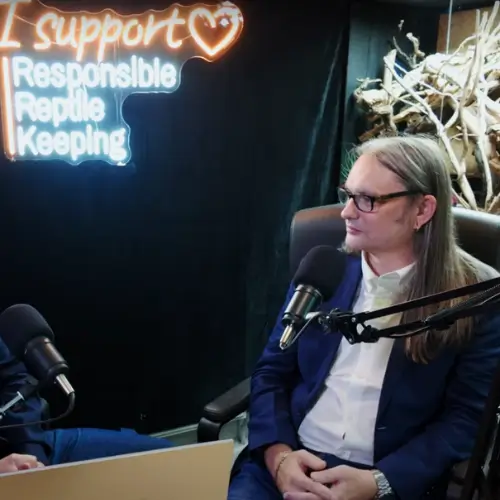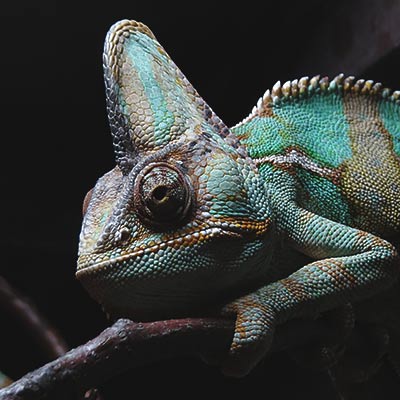
It’s a revolution! And it’s called EvoRx. Join Tony and John Courteney-Smith as they discuss the groundbreaking new snake food from @ArcadiaReptile – EvoRx®. EvoRx® replaces frozen rodents with a safe, lean and even more ethical alternative. It’s been crafted by experts as an optimised feeding solution.
In this episode, John discusses the exciting new product line by Arcadia called, LumenIZE. LumenIZE takes reptile lighting to the next level by giving the keeper full control, allowing them to replicate solar activity from dawn to dusk and everything in between including the ability to increase and decrease both visible light and UVI through the course of a day. John discusses the R&D, functionality, welfare benefits to our animals, and more!
In this episode, John discusses the true definition of “bioactivity”, common myths and mistakes that are made with bioactive setups, and whether or not bioactivity is necessary or important.
The second half of the discussion revolves around UV LED lighting. John shares what the latest science says about UV-producing LED bulbs, whether or not they are safe to use and potential problems generated through their use.
In the episode, John expands on his concept of the 3 parameters of overall nutrition, including lighting/heat, moisture cycles, and physical and mental enrichment.
John is the author of a series of incredibly popular reptile and amphibian guides including Bio Activity and the Theory of Wild Re-Creation® and his latest, Fire, the Sun & Its Replication in Reptile Keeping.
Today he joins us to talk about Metabolic Bone Disease and UVB. John has a mission to eradicate this affliction and spends a great deal of time educating the community on UVB and Vitamin D3.
He has written The Arcadia Guide to MBD and its Elimination in Captivity. This podcast episode is an introduction to that book. It is an excellent read and I highly recommend adding it to your library. In the US, you may purchase a physical book from Light Your Reptiles or get a kindle edition from Amazon.com. In the UK you can head on over to the Northampton Reptile Centre. For the month of January 2017, both Light Your Reptiles and Northampton Reptile Centre will be having a sale on this title!
John Courteney-Smith, MRSB is the Reptile Products Manager at Arcadia-Reptile. It is his job to push captive husbandry as close to optimal health for our reptiles and amphibians as possible – and make that products that allow this to be carried out.
He is also the author of a set of books which address the many aspects of keeping healthy reptiles in captivity. Last month, in episode 55, we discussed his first book, The Arcadia Guide to MBD and its elimination in captivity.
And if you haven’t heard it, I suggest going back and catching that one! Today we are going to go over his second book, The Arcadia Guide to Reptile and Amphibian Nutrition. It is a huge topic and will not fit in one podcast so we will break it up. This episode we will concentrate on vitamins. Of course, all vitamins and minerals work together and must be in balance so it is impossible to discuss one without the other. There is a great deal of overlap!
The overlap is actually an important point. John talks about the “entourage effect” which says that our bodies require the vitamins and minerals together and in balance to be fully effective.
Both vitamins and minerals are critical components to our chameleon’s health. This is the second part of our nutrition series where we focus on minerals. This episode is based on John’s book The Arcadia Guide to Reptile and Amphibian Nutrition.
John Courteney-Smith, MRSB is the Reptile Products Manager at Arcadia-Reptile. It is his job to push captive husbandry as close to optimal health for our reptiles and amphibians as possible – and make that products that allow this to be carried out. He is also the author of a set of books which address the many aspects of keeping healthy reptiles in captivity. In episode 55, we discussed his first book, The Arcadia Guide to MBD and its elimination in captivity. And if you haven’t heard it, I suggest going back and catching that one! In episode 59 we started on his second book, The Arcadia Guide to Reptile and Amphibian Nutrition. In that episode we concentrated on vitamins. Of course, all vitamins and minerals work together and must be in balance so it is impossible to discuss one without the other. Naturally, our next episode, this one, is about minerals!
I highly recommend picking up the book as it is full of information. With everything we cover in over two hours of discussion in this podcast it is still just an introduction!
Today we are going to be talking about gutloading the feeders for your chameleon. This conversation is loosely based on the end chapters of his book “The Arcadia Guide to Reptile & Amphibian Nutrition”.
John Courteney-Smith, MRSB is the Head of Science and Innovation at Arcadia-Reptile. It is his job to push captive husbandry as close to optimal health for our reptiles and amphibians as possible – and make that products that allow this to be carried out. He is also the author of a set of books which address the many aspects of keeping healthy reptiles in captivity. In episode 55, we discussed his first book, The Arcadia Guide to MBD and its elimination in captivity. And if you haven’t heard it, I suggest going back and catching that one! In episode 59 we started on his second book, The Arcadia Guide to Reptile and Amphibian Nutrition. In that episode we concentrated on vitamins. Of course, all vitamins and minerals work together and must be in balance so it is impossible to discuss one without the other. Naturally, our next episode, episode 60, was about minerals! Today we finish up the nutrition discussion with a talk on gutloading feeders.
Bio-active environments have captured many people’s imaginations. It is the most true approach to creating a “slice of nature” in our living rooms.
But more than just a pretty scene, bio-active environments can be more healthy for your chameleon or other reptiles. Join John Courteney-Smith and I in exploring bio-active environments!
Bio-active environments have captured many people’s imaginations.
It is the most true approach to creating a “slice of nature” in our living rooms. But more than just a pretty scene, bio-active environments can be more healthy for your chameleon or other reptiles. Join John Courteney-Smith and I in exploring bio-active environments!
As most of you know, this episode is just one of a series of episodes dedicated to MBD education. As part of this series we are following the story of Sweet Pea, a female Veiled Chameleon with MBD that went home with Marianne Bolin.
We are following this in real time and I will give you an update in each of the MBD series episodes. While I am not sure how this will end, Today I bring to you some surprisingly good news. She was climbing the walls of her screen cage. Listeners of this podcast will know that screen crawling is a sign of an inadequate cage and that the chameleon wants to get out. It does not mean it wants to play. It means it doesn’t like where it is. I will say this is the first time I have been ecstatic to hear about a chameleon screen climbing! The fact that Sweet Pea has that kind of ability makes me very happy.
What I am about to share with you was initially meant to be an interview asking John Courteney-Smith, the Head of Science and Innovation at Arcadia reptile, what was in store for us in the coming year with regards to lighting and supplements.
What ended up happening was more of a conversation about topics that we both are working on. We certainly talked about lighting technology and where it is going, but I felt that I’d like to include you in on some of our conversations about fat soluble vitamins and the consequences of cheap lighting fixtures. So there really isn’t a formal start to this talk! I am going to jump us in right about the point where John and I were talking about the danger of going cheap when setting up the electronics for our caging. He starts taking about what to look for to tell you that your fixture is shortening the life of your bulb and I knew this had to be shared. Once we talk about that I get around to the business at hand and we talk about product lines!
Welcome to Animals at Home! My name is Dillon and I am the creator of most of the content found on this site. I have been in the reptile hobby for over a decade. I have been passionate about animals as far back as I can remember. My goal with the content I produce is the following:
We have a great season ahead! In today’s podcast I talk about the direction we will be going. I will have the standard wide range of episode topics that you are used to, but we will be hitting certain topics hard to try and get some results in our personal husbandry.
If you have already listened to the podcast and are here wondering what the next step is then you have come to the right place! The two themes we will work on are Keeping Plants Alive and Understanding UVB.















